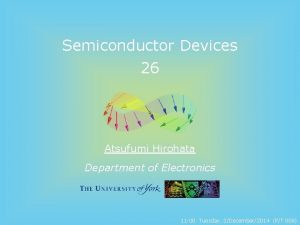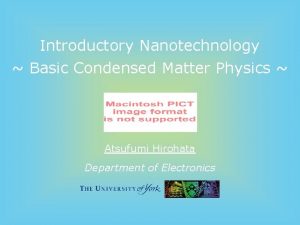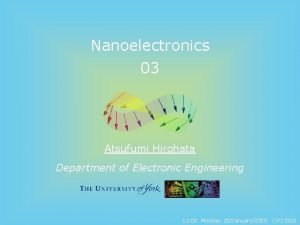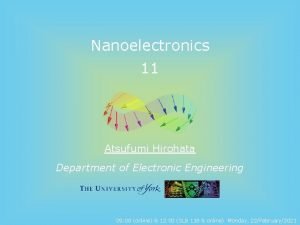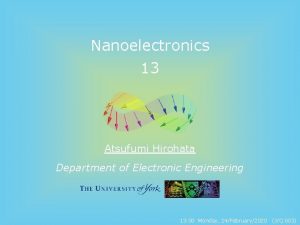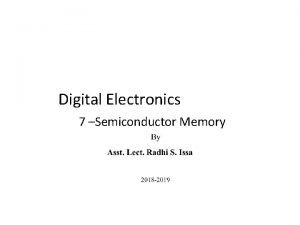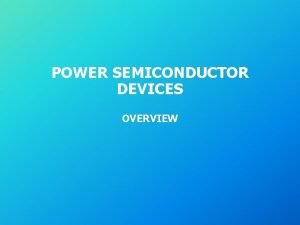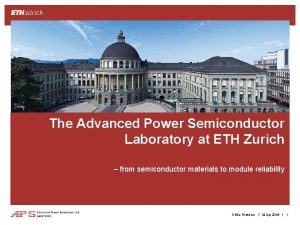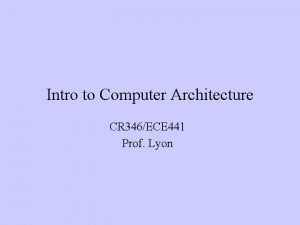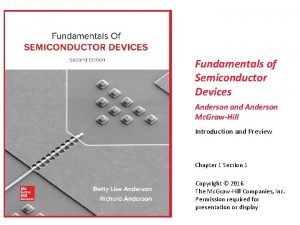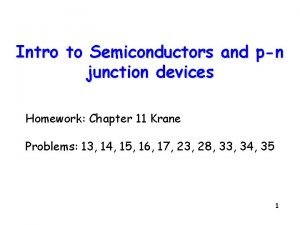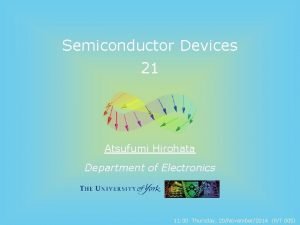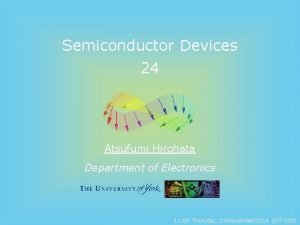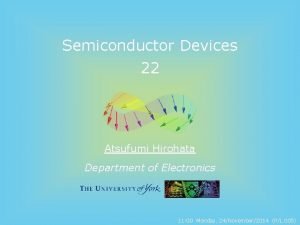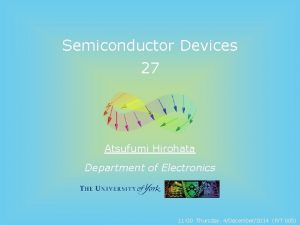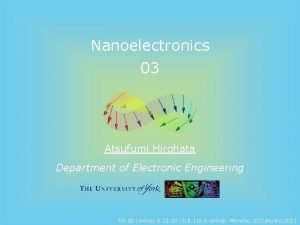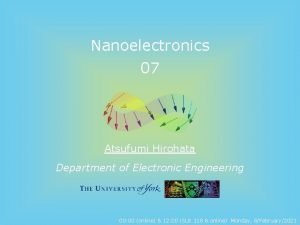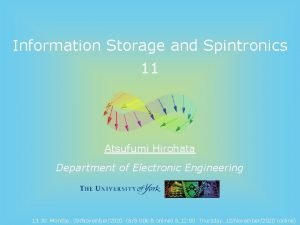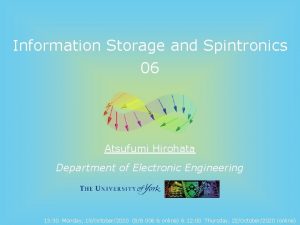Semiconductor Devices 25 Atsufumi Hirohata Department of Electronics















- Slides: 15

Semiconductor Devices 25 Atsufumi Hirohata Department of Electronics 11: 00 Monday, 1/December/2014 (P/L 005)

Exercise 4 Calculate the depletion layer width of an abrupt p-n junction diode which is made from Silicon and has the following properties: p-region: doping density of NA = 2 1021 m-3 n-region: doping density of ND = 1 1021 m-3 permittivity: e = e e 0 = 12. 0 8. 854 10 -12 F/m and q = 1. 6 10 -19 C.

Answer to Exercise 4 The depletion layer widths are defined as (Here, Vbi = 590 m. V from the previous exercise 3. ) By substituting the given values into the above relationship,

25 Metal Semiconductor Junction • Work function • Metal / n-type semiconductor • Metal / p-type semiconductor Einstein relationship • • Schottky barrier

p-n Diode A junction made by attaching p- and n-doped semiconductors : Widely used to insulate transistors. Common circuit to convert ac to dc in a battery charger. * http: //www. wikipedia. org/

Metal Junctions Work function : Current density of thermoelectrons : vacuum level 3 s 2 p Richardson-Dushman equation A : Richardson constant (~120 A cm 2/K) 2 s Metal - metal junction : EFA A EFA barrier A + - + + - B vacuum level A - B : contact potential EFB = EFA - EFB B EFB A A - B B EFA = EFB 1 s Na 11+ EF

Metal - Semiconductor Junction - n-Type Metal - n-type semiconductor junction : vacuum level S M S : electron affinity EC : conduction band ED : donor level EFS EFM M n-S EV : valence band depletion layer q. Vd = M - S : Schottky barrier height M - S EFM M - ++ ++ - EC ED EFS n-S EV * http: //www. dpg-physik. de/

Metal - Semiconductor Junction - p-Type Metal - p-type semiconductor junction : vacuum level S : electron affinity M S EFM M EC p-S EFS EA : acceptor level EV depletion layer EC S - M EFM M + + q. Vd = S - M p-S EFS EA EV

Schottky Barrier Definition of energy at the Schottly barrier : * S. M. Sze, Physics of Semiconductor Devices (Wiley, New York, 2006).

Einstein Relationship At the equillibrium state, Numbers of electrons diffuses towards -x direction are EC ED EF (-x direction) (n : electron number density, De : diffusion coefficient) Drift velocity of electrons with mobility e under E is Numbers of electrons travel towards +x direction under E are (+x direction) As E is generated by the gradient of EC, E is along -x and vd is +x. (equillibrium state) Assuming EV = 0, electron number density is defined as EV x

Einstein Relationship (Cont'd) Now, an electric field E produces voltage VCF = VC - VF Accordingly, Einstein relationship Therefore, a current density Jn can be calculated as

Rectification in a Schottky Junction By applying a bias voltage V onto a metal - n-type semiconductor junction : M - S q(Vd - V) forward bias J V reverse bias * H. Ibach and H. Lüth, Solid-State Physics (Springer, Berlin, 2003).

Comparison between p-n and Schottky Junctions Current I Current-voltage characteristics : Schottky diode p-n diode Voltage V * S. Kishino, Physics of Semiconductor Devices (Maruzen, Tokyo, 1995).

Transport across a Schottky Barrier Four major transport across the Schottly barrier : Thermionic transport Tunnelling transport Recombination Hole injection Forward bias * S. M. Sze, Physics of Semiconductor Devices (Wiley, New York, 2006).

Exercise 5 State the following metals in contact with Si to form either Schottky or Ohmic contacts based on their energy diagram. Assume the following parameters: Si electron affinity: = 4. 05 e. V and Si bandgap: Eg = 1. 11 e. V. Metal Work function n-type M [e. V] Si Pt 6. 30 Au 4. 80 Cu 4. 18 Ni 4. 01 p-type Si
 Atsufumi hirohata
Atsufumi hirohata Atsufumi hirohata
Atsufumi hirohata Atsufumi hirohata
Atsufumi hirohata Atsufumi hirohata
Atsufumi hirohata Atsufumi hirohata
Atsufumi hirohata Fermi velocity
Fermi velocity Atsufumi hirohata
Atsufumi hirohata Difference between ram and rom in digital electronics
Difference between ram and rom in digital electronics It department odisha
It department odisha Department of electronics & information technology
Department of electronics & information technology Classification of power semiconductor devices
Classification of power semiconductor devices Power semiconductor devices
Power semiconductor devices Power semiconductor devices lecture notes
Power semiconductor devices lecture notes Semiconductor devices
Semiconductor devices Fundamentals of semiconductor devices anderson pdf
Fundamentals of semiconductor devices anderson pdf Semiconductor junction devices
Semiconductor junction devices
